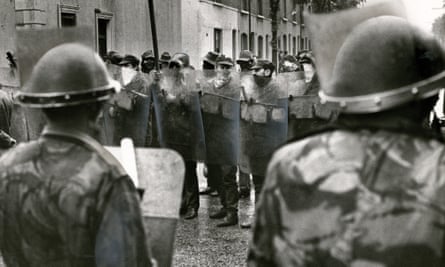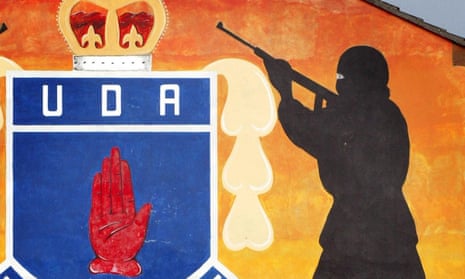The loyalist terror group the Ulster Defence Association is still in existence and refuses to dissolve, it has announced.
At one time it was the largest loyalist paramilitary organisation, with thousands of members across Northern Ireland. It has now said it has no intention of disappearing.
The UDA statement comes as political parties represented in the Stormont assembly continue talks aimed at saving power sharing in the region. At the heart of the latest crisis destabilising devolution are allegations of ongoing paramilitary activity – most notably claims that the Provisional IRA still exists and was responsible for murdering ex-member Kevin McGuigan in August.
The UDA’s intervention will further complicate negotiations between unionist and nationalist parties, chaired by the British and Irish governments. A report drawn up by three government-appointed security, legal and academic experts is to be released this month, which will rule on the status of the IRA and other paramilitary organisations.
In the current edition of Ulster magazine – the official organ of the UDA since the 1980s – the loyalist movement reflects on the current stalemate at Stormont. “We will wait and see which way it pans out but rest assured the UDA are still in existence and won’t be leaving any stage whilst republicans of any faction still exist. The organisation was set up with the protection of their community at its heart and this we will maintain.”
In 2007, the UDA said that its “military war” was over and three years later its leadership said “all weaponry” had been decommissioned. However, a number of individual UDA units, particularly in north Antrim and the east Antrim coast, are believed to have held on to weapons and been involved in a slow-burning feud with the mainstream UDA, led by former prisoner Jackie McDonald.
Ulster magazine reflects the views of McDonald and his political allies in the Ulster Political Research group. McDonald has been a strong supporter of the peace process and power sharing. He has built up a close working relationship with the UDA’s former IRA and Sinn Féin enemies.
It was formed out of street militias and vigilante groups in the early 1970s and the UDA was both a mass, working-class Protestant movement, and a sectarian killing machine. It pioneered sectarian torture-killings in the early 1970s with one of its most notorious killers, John White, stabbing to death a nationalist politician and his female friend 147 times, after the pair had been abducted.

The UDA also provided “street muscle” for the Ulster Workers’ Council strike in May 1974, when industrial action by Protestants brought down the last power-sharing executive in Northern Ireland.
The organisation was also heavily infiltrated by the security forces, with allegations that the police and army helped UDA killing units target republicans and nationalists – including the Belfast solicitor Pat Finucane.
